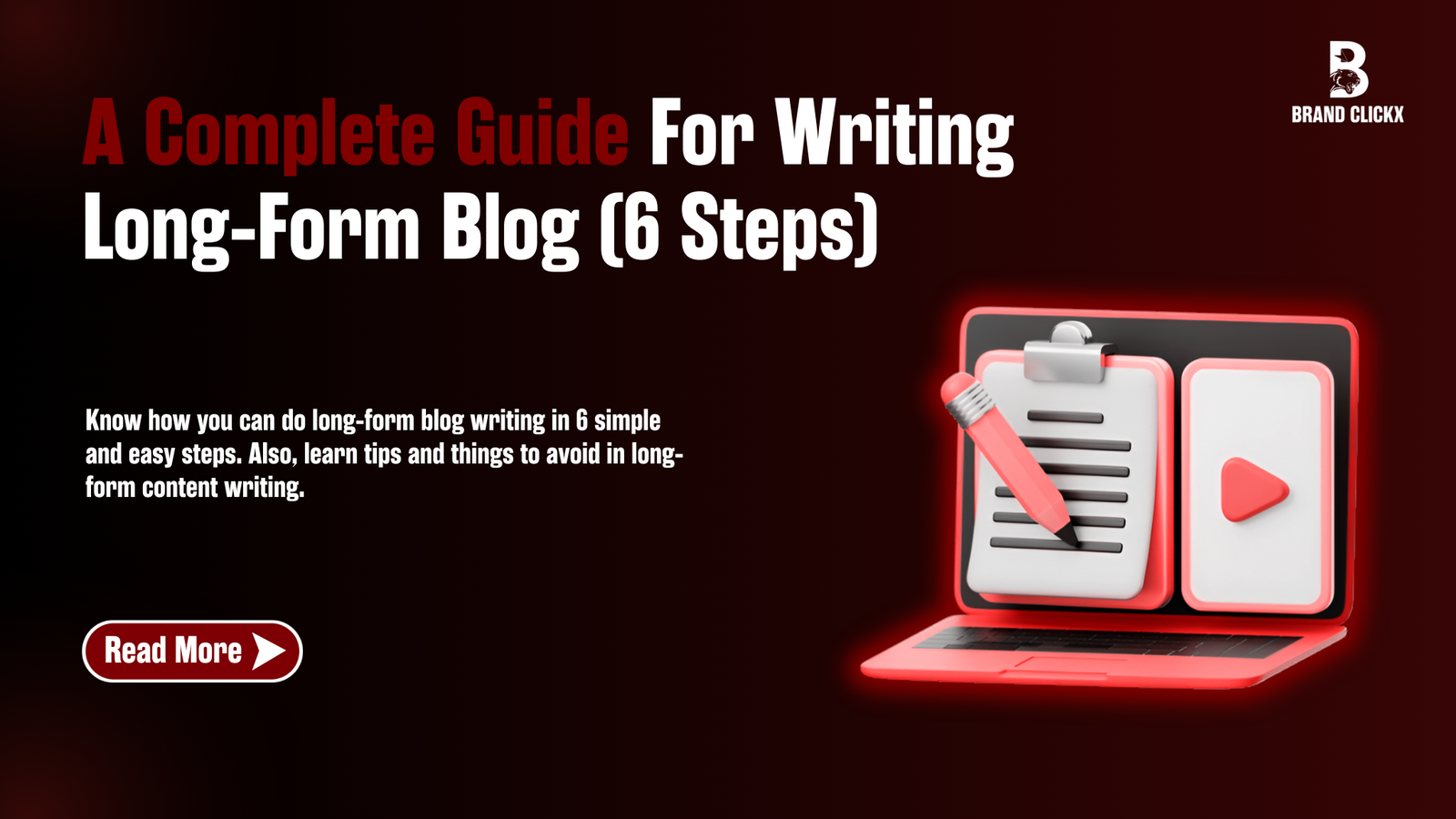Are your short blog posts failing to deliver what readers need? Your content also fails to provide the needed information. You want your readers to stay on your pages longer and get unforgettable value from your content.
Then, you must write long form content that solves all the above problems. However, your goal should be to deliver informative and valuable content that solves problems.
Moreover, long form blog writing benefits everyone in marketing, blogging, and search engine optimization as it improves your ranking and conversion strategy.
However, this blog will tell you everything about long form blog writing, including tips and things to avoid in long-form content writing. So let’s get started!
What is Long Form Blog Writing?
Long-form blog writing is content that usually exceeds 1,000 words. It dives deep into a specific topic, sharing detailed insights and useful information. Unlike short blogs that just touch on the basics, long-form posts give readers all the information they need.
For instance, a 500-word blog article may guide starting a blog, while a longer piece might provide more in-depth examples, explanations, and practical suggestions. Long-form content is especially helpful for readers looking for detailed answers and for subjects that require careful study.
Moreover, search engines tend to prefer long-form blogs since they offer more value to readers. However, 61% of bloggers typically publish content between 500 and 1500 words. These blogs ranked well in 2023, and readers have also enjoyed them. Posts like these boost your chances of ranking higher in search results.
When you dive deep into a topic and cover it from different angles, long-form content draws in more organic traffic and keeps readers interested for a longer time.
Why is Long Form Content Writing Important?
Long-form content writing is important for the following reasons:
Boosts SEO Rankings
Search engines really like content that gives detailed and complete answers. If your blog post is longer and more thorough, you’re likely to rank higher in search engine results.
For example, our blog, How to Create Content for Local Landing Pages That Ranks, discusses everything about writing content for local landing pages.
Builds Authority
Writing in-depth content really shows that you know what you’re talking about. A thorough and well-researched post helps you to present yourself as an authority to both readers and search engines.
This helps you gain more trust from Google and also helps you get more backlinks. As your blogs become more informative, helpful, and valuable, more people will link to them.
Engages Readers
If your content is helpful, readers are likely to stay longer. But how can you engage your readers on the blog? It’s easy. You can engage your readers by using:
- Easy to skim headings and structure.
- Images and visuals
- Asking relevant questions.
- Storytelling techniques
Earns More Shares
People really enjoy sharing content that offers unique solutions. When your blog shares new ideas, people are more likely to pass it along to their friends. Check out blogs like HubSpot’s marketing guides, which are great examples of long-form blog writing.
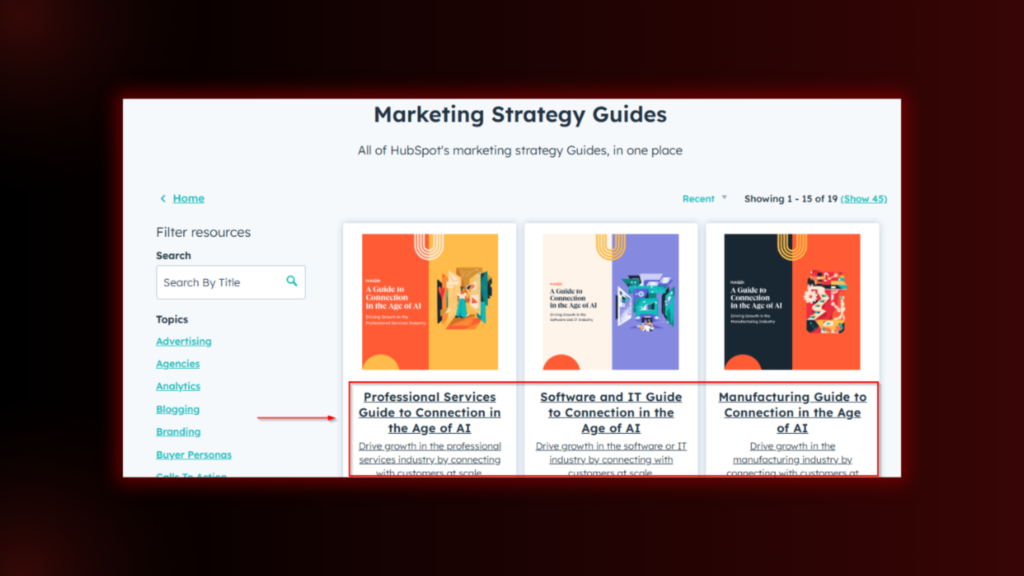
These posts get into the details, making them perfect resources for readers.
6 Steps for Long Form Blog Writing
Writing a lengthy blog might seem a bit difficult at first, but trust me, it’s not as tough as it looks.
Let’s walk through step-by-step instructions on how to create an engaging long-form post.
1. Pick a Topic Your Audience Cares About
Start by identifying something that your audience is curious about. You can do this by conducting keyword research using tools such as Google Trends, AnswerThePublic, and SemRush.
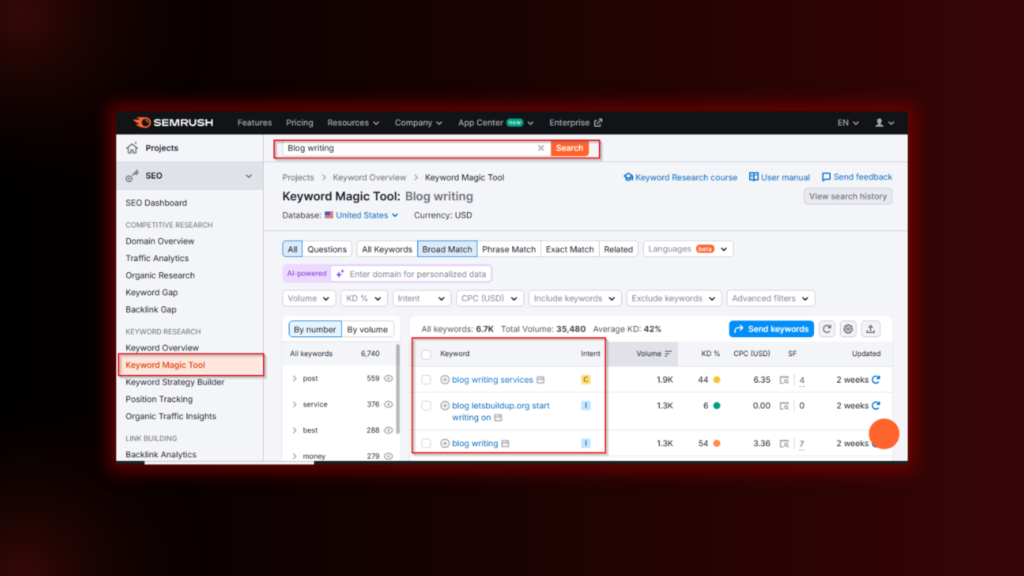
For instance, if your audience is looking for SEO tips, you can write about “Best SEO Practices for 2025.”
However, when doing keyword research, look for parameters like monthly traffic and SEO difficulty. The lower the KD, the higher the chances of ranking for that particular keyword. Also, the higher the search volume, the higher the chances of getting more traffic.
2. Research Thoroughly
A great blog really relies on solid research as its backbone. Collect some stats, case studies, and expert opinions to support your arguments. You can use different forum websites like Quora and Reddit to gain insights about your target audience.
Moreover, you can also use the prompt,” Your keyword+Cite:Quora.com”, to find different questions people ask. This will give an idea of what your target audience wants to know.
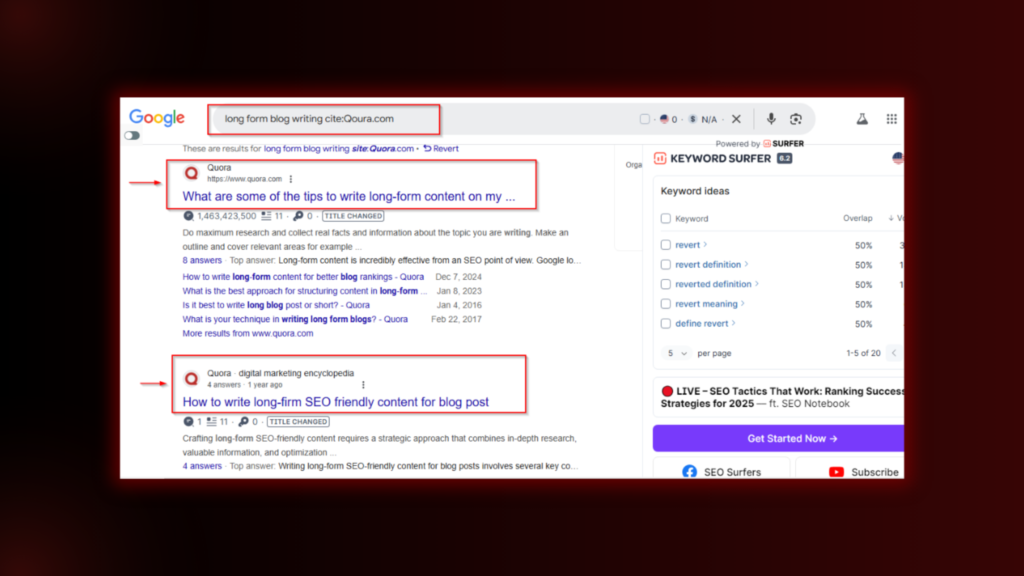
Moreover, you can also use AI tools like ChatGpt and Perplexity to conduct research and gather information.
Your competitors can also help and inspire you. Blogs such as MarketMuse provide good Long-form content examples by combining facts, images, and practical recommendations.
You can then examine your competitors, draw inspiration from them, and write better content for them.
3. Create a Clear Outline
An outline helps organize your text and makes it easier to understand. Use helpful titles to divide your blog into readable sections. For instance, this blog’s outline includes an intro, steps, tips, and FAQs.
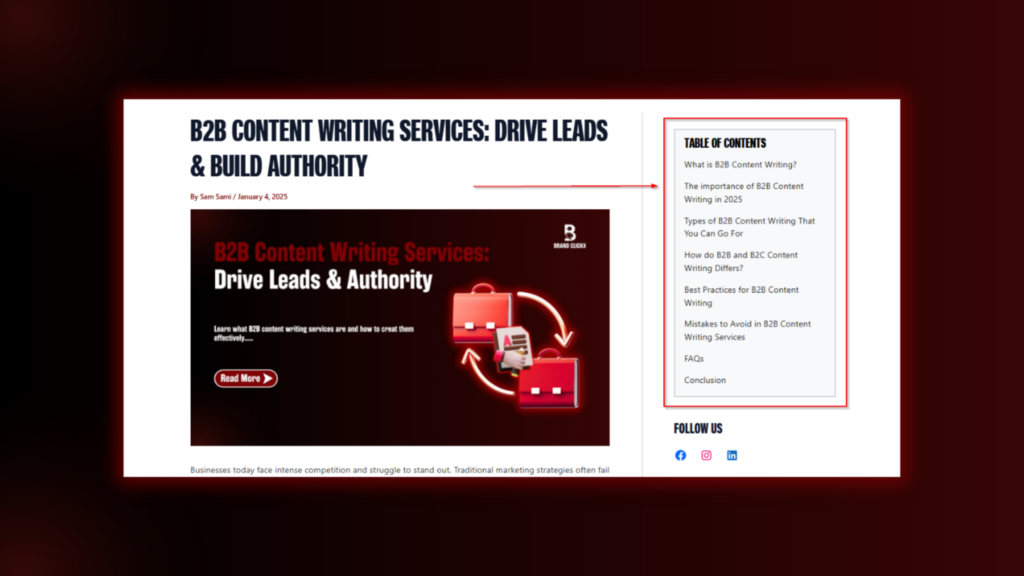
Why is it important? It gives the reader a glance at what is in your blog post. So, focus on making a well-targeted and optimised outline. Another factor is that today’s readers are skimmers, so try to write subheadings very carefully so that they can find the most relevant information quickly.
4. Write an Engaging Introduction
The introduction shapes the rest of the blog. Begin with a question that many people can relate to, a strong statement, or an unexpected fact.
For instance: “Did you know that blogs with more than 2,000 words get a better Google ranking?
5. Keep Your Content Reader-Friendly
Keep your paragraphs and sentences short. This will make your text easier to read. To make long text easier to read, use bullet points, visuals, and subheadings.
For instance:
- You can use lists to highlight key points.
- Including images helps make complex ideas more straightforward.
6. Add Unique Value
Do not give your readers the same old bland recommendation. Share your perspective or thoughts to give your blog a unique touch.
Instead of just listing AI-based SEO tools like every other blog, dive deeper into how these tools solve specific problems that manual SEO methods can’t handle. For instance:
Don’t just say, “Tool X helps with keyword research.” Instead, explain: “Tool X uses AI-driven NLP to analyse user intent, allowing you to identify long-tail keywords that your competitors overlook. This can give you a significant edge in targeting niche audiences.”
Focusing on specific use cases, hidden benefits, or expert insights will make your article stand out from competitors’ generic overviews.
Tips for Writing Long Form Content
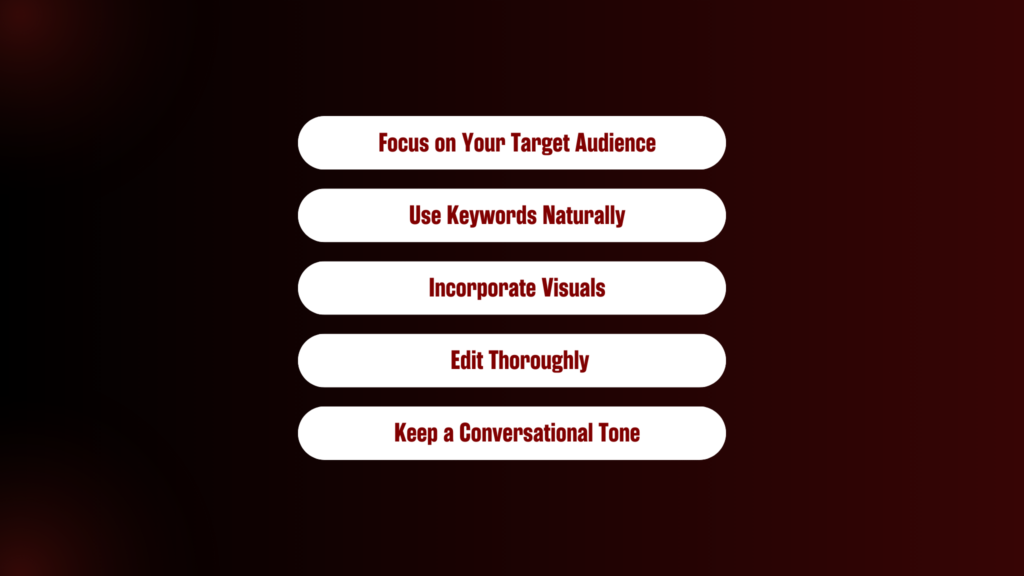
Want to master long-form content writing? Here are six tips for writing long-form content that will engage and inform your audience:
1. Focus on Your Target Audience
Write with your readers’ pain points in mind. Ask yourself what they want to learn from this post. Use tools like Answerthepublic to find out what your target audience is searching for.
2. Use Keywords Naturally
Don’t use keywords again and again; instead, use them naturally. How? By using its variations and LSI terms that are closely related to the primary keyword. As of now, Google prefers topics over keywords. So, write your blogs on topics and use keywords naturally.
3. Incorporate Visuals
Images, charts, and infographics make your content more engaging. For example, HubSpot’s marketing blogs often feature helpful visuals.
4. Edit Thoroughly
Long-form content requires careful editing. Check for grammar, flow, and readability before publishing.
5. Keep a Conversational Tone
Instead of writing
“To optimize your content effectively, leverage AI tools to identify opportunities.” Write:
“To improve your content, use AI tools to find new opportunities.”
Try to use language that is easier to understand. This will make. This will reduce the information to as few words as possible. Use shorter, simpler, and easy-to-understand language. It makes the content approachable and relatable.
Things to Avoid in Long Form Content Writing
Even seasoned writers can make mistakes with long-form content. Here are some common pitfalls to avoid:
1. Fluff and Filler Content
Don’t write just to hit a word count. Every sentence should add value to your reader’s understanding. For example, instead of writing: “AI SEO tools are very useful. They help in many ways, such as keyword research, content optimization, and competitor analysis. These tools make SEO easier, faster, and better.”
Write, “AI SEO tools streamline keyword research, optimize content, and analyse competitors. They save time and improve results, making SEO more efficient.”
The second version is concise, avoids redundancy, and delivers the same value without filler sentences. It respects the reader’s time while still being informative.
2. Lack of Structure
Unorganised content confuses readers and makes them leave your blog at once. Stick to your outline to keep your blog clear and logical. Also, use more white spaces and bullet points within your main structure to increase readability.
3. Overloading with Keywords
Keyword stuffing ruins readability and can hurt SEO rankings. Instead of focusing on the number of times a keyword is used in your blog, write naturally. Try to use them where they fit. If not, then use the variations or avoid them at all.
For Example, Instead of this keyword-stuffed sentence:
“AI-based SEO tools are the best AI-based SEO tools to use if you’re looking for AI-based SEO tools that help improve your SEO rankings with AI-based SEO tools.”
Write naturally like this:
“AI-based SEO tools help improve rankings by streamlining tasks like keyword research and content optimization. These tools offer smart solutions tailored to modern SEO needs.”
In the second version, the primary keyword is used naturally, and synonyms like “smart solutions” enhance readability without overloading the text. This approach keeps the writing user-friendly and SEO-compliant.
4. Ignoring Visual Appeal
Long walls of text are hard to read. Break up paragraphs and use visuals to keep readers engaged. Use more white space and bullet points for better visibility. Also, use images, infographics, and screenshots to enhance the physician beauty of your blog.
By avoiding these mistakes, you can create blogs that readers love.
FAQs
Q1: What are some tips for writing long form content?
Follow the following tips for writing a long-form blog:
- Start with an outline.
- Research thoroughly.
- Focus on the reader’s needs.
- Keep the language simple.
- Use short paragraphs.
- Add visuals like images or infographics.
- Edit and remove fluff.
- Include internal and external links.
- End with a clear call to action.
Q2: How do you write a long blog?
Break the process into manageable steps: Research, outline, write, and edit. Focus on value, not word count.
Q3: Is long form content good for SEO?
Absolutely! Search engines prioritise detailed, well-researched blogs. They rank higher because they answer more user queries.
Q4: Is long form content dying?
Not at all! While trends evolve, quality content remains king. People still value in-depth blogs that provide actionable insights.
Conclusion
Long form blog writing is a powerful tool for engaging your audience and building authority. It builds trust, improves SEO, and positions you as an authority. By following the steps and tips in this guide, you can create content that resonates with your target audience and ranks.
But if you can’t write long-form content and want to convert your readers into customers, then contact us today.

